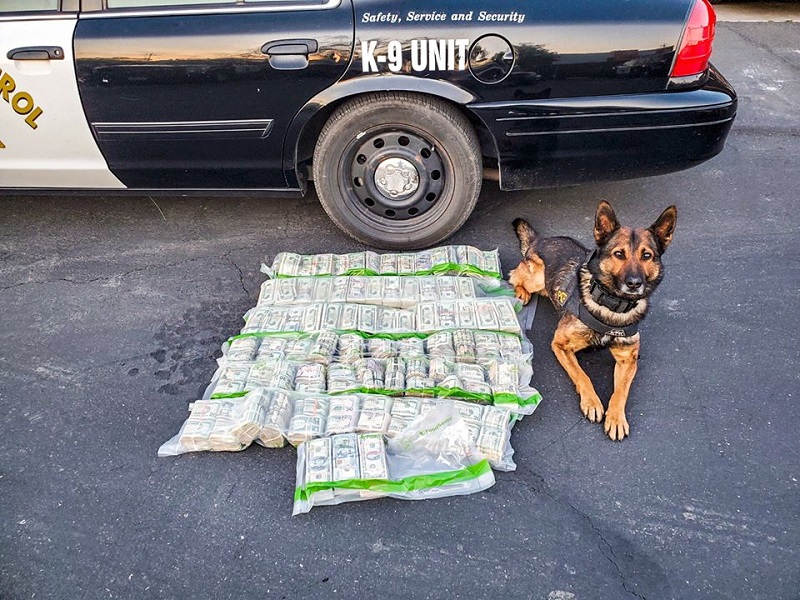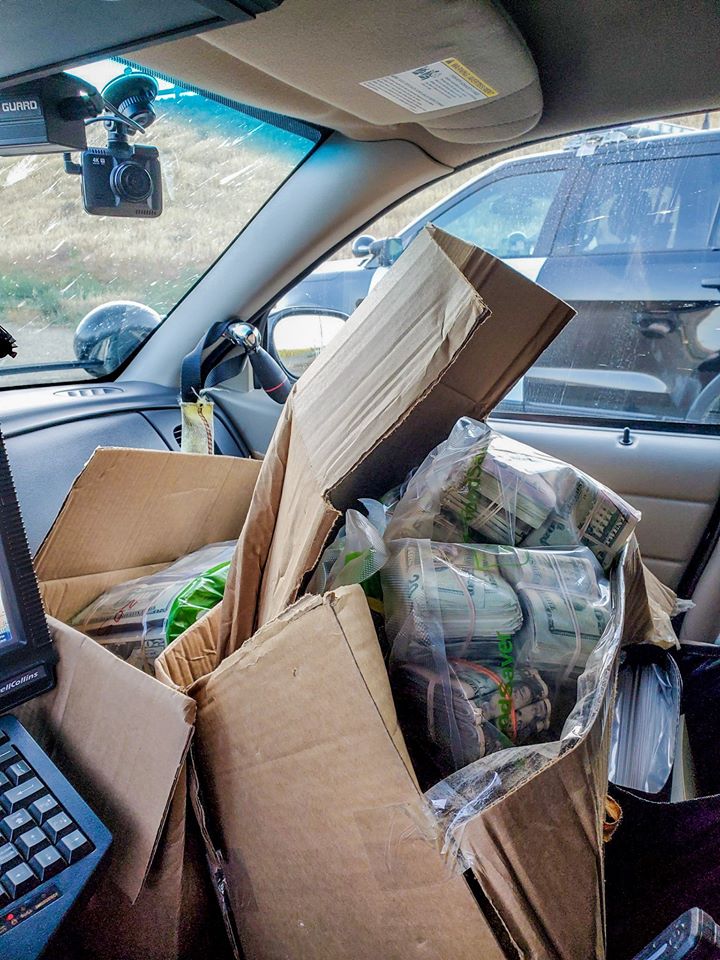

It’s not every day that someone tosses almost $1 million out the car window. It is every day that keen cops armed with acute observation skills detect basic traffic infractions leading to some enormous catches.
That is what unfolded May 2 when a California Highway Patrol (CHP) officer and his police K9 Beny were piqued by three black SUVs seemingly traversing in a caravan on a highway routing through agricultural landscape.
Such is the ordinary impetus for many law enforcement encounters, traffic infractions were observed. Like some police-initiated contacts, motorists flee. And that was the game-on signal which lead a CHP cop and his police canine on a high-speed pursuit while trying to account for three vehicles to his solo patrol cruiser—but that would soon change.
Upon initiating the traffic stop for the observed traffic infraction(s), the CHP cop focused on one of the three SUVs: a black 2020 Chevrolet Suburban. With lights ablaze and siren wailing, the Suburban’s driver decided stopping was not in his cards. He mashed hard on the gas pedal; so did the CHP officer while notifying his communications center that he was engaging in a pursuit.
Then it got hairy.
“As the officer attempted to pursue the Chevrolet Suburban, one of the other SUVs, a black Ford Expedition, attempted to block the officer, straddling the lanes, according to a CHP press release. That action right there confirmed the caravan of three SUVs were associated. And the Ford driver blocking the CHP cop from going after the Chevy preliminary telegraphed the trio were protecting something from the eyes of the law.
A drug interdiction training I recently attended (retired cops like me love continuing education credits too) availed some fascinating psychology of drug cartel types and law enforcement principles to use during the exact circumstances confronting the CHP cop in our story. The bad guys running drugs (or related things like dirty money) ride shotgun for one another, looking out for police presence, circumventing attention, acting like a string of cute little ducklings innocently paddling all in a row. Picture-perfect, eh?
To a law enforcement officer, that barks for attention. Sure enough, our cop observed traffic infractions, delivering the probable cause to take a closer look. Exactly what this cluster of three did not want. Such is the cat-and-mouse game played among cops and robbers (or carriers of contraband).
Back to our chase. Following is the verbatim account as told by the California Highway Patrol: “The officer was able to outmaneuver the Ford Expedition and continued to pursue the Chevrolet Suburban. At one point during the pursuit, the driver of the Chevrolet Suburban stopped on the right shoulder [he must’ve accomplished a decent lead], exited the vehicle and dropped two cardboard boxes before returning to the vehicle and continuing to flee. The Ford Expedition changed directions during the pursuit and was not seen or located.”

These described actions indicate that they felt with whatever was in those cardboard boxes no longer in their possession, it was time to divert, since one cop can’t pursue three cars at once.
Continuing CHP’s account: “Shortly after dropping the boxes on the shoulder, the driver of the Chevrolet Suburban stopped his vehicle and surrendered.” Yep, the What boxes? routine would surely ensue, denial spouting like the insistence and din of the Niagara Falls.
What else came of this Merced mayhem? “While taking the [Chevrolet Suburban] driver into custody [for fleeing and eluding charges, at least], the officer noticed the third SUV, a black 2019 Chevrolet Tahoe, stopped in traffic.” Trying to blend in, but it was a no-go. At this point it appears more CHP cops arrived.
“The officers stopped the Chevrolet Tahoe and took both drivers into custody. During the incident, Merced Communications center received several 911 calls regarding the cardboard boxes that were dropped off on the shoulder.” Any guesses?
“Officers retrieved the cardboard boxes and located U.S. currency estimated to be $915,000. Officers also discovered walkie talkies in the suspect vehicles and later learned the three drivers were using them to communicate during the pursuit.” That’s a lot of money, and the use of walkie talkies among thieves and drug runners is not unusual.

Lest we forget K9 Beny, I am sure his barking and whines to get a piece of the action throughout this pursuit elevated his typical crime-fighting frenzy: “K9 Beny subsequently alerted to the odor of narcotics on the currency and it was later discovered the suspects were traveling to northern California to purchase marijuana.”
Not bad police work at all: almost $1 million in seized drug money, three arrests adding up to multiple felonies, three seized late-model SUVs, a pair of walkie talkies, and one happy canine who punctuated the whole saga with a nice epilogue (otherwise known as “he’s a good boy”).
Given their incredible olfactory glands and the ability to sniff out narcotics for a living, CHP K9 Beny gave the plastic-bagged bundles of cash a smell test. Why would a cop (his dog) want to put nose to dirty money? The answer to that is in a related question: Why would a motorist toss almost $1,000,000 out the car window on a semi desolate highway? Training and evidentiary value are essential in police work; drug cartels can afford expensive defense lawyers to malign the system and look for loose threads in the cops’ narrative of events.
The enormous amount of cash bundled and plastic-wrapped and stuffed in cardboard boxes all handled by drug couriers just might trigger a canine’s splendid nose skills…coupled with the intrigue of law enforcement officers leading to well beyond 20 questions. The dividends of which are tantamount to great courtroom testimony (if it gets that far). Truth is, this pile of cash which is extraordinarily eye-opening to you or me is a mere penny to drug cartels.
Expectedly, K9 Beny alerted that the roadside cash wads had been through the drug mill (close to a pun). Police canines are trained to sniff out drugs, and residue does not necessarily slip through the cracks (in this case, wrinkles in mint green).
In police work, you are only as good (safe) as your back-up enables you to be (watchful), with a certain degree of confidence and an oath as the binding agent. K9 Beny and his handler scored big here.